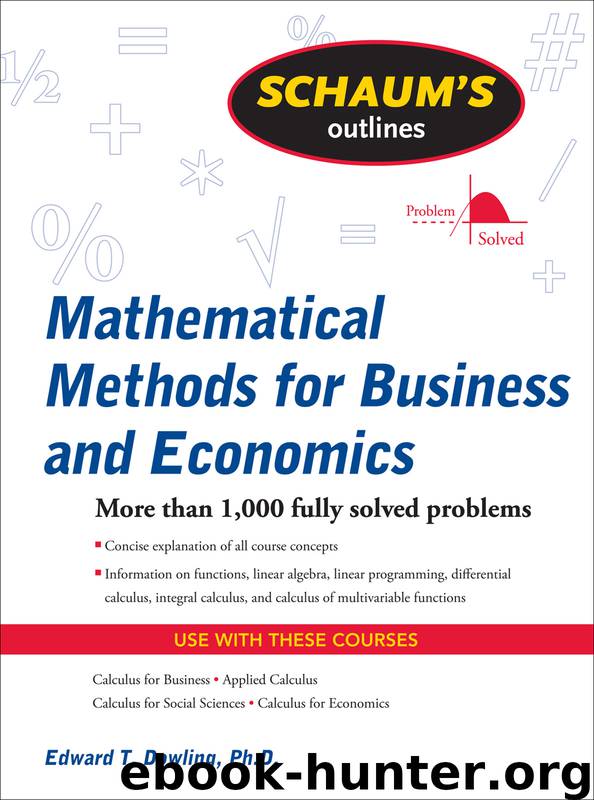Mathematical Methods for Business and Economics by Edward T. Dowling

Author:Edward T. Dowling
Language: eng
Format: epub
Publisher: McGraw-Hill
Published: 1993-08-23T16:00:00+00:00
x1 + x2 + 3x3 ≤ 4
x1, x2, x3, ≥ 0
(a)
2x1 + x2 + x3 + s1 = 2
x1 + x2 + 3x3 + s2 = 4
In matrix form,
(b) With v = 5 and n = 2, 5 − 2 = 3 variables must be set equal to zero for a basic solution. Setting x1 = x2 = x3 = 0, the initial basic solution is s1 = 2 and s2 = 4.
7.23. Find the total number of basic solutions that exist in Problem 7.22.
Substituting v = 5 and n = 2 in the formula.
Supplementary Problems
MATHEMATICAL EXPRESSION OF BUSINESS AND ECONOMIC PROBLEMS
7.24. A bakery makes $4 profit on its wedding cakes x1 and $3 on its birthday cakes x2. Wedding cakes take 4 minutes for mixing, 90 minutes for baking, and 8 minutes for icing. Birthday cakes take 6 minutes for mixing, 15 minutes for baking, and 4 minutes for icing. The bakery has 120 minutes of mixing time, 900 minutes of baking time, and 96 minutes of icing time. Express the data in terms of equations and inequalities necessary to determine the combination of wedding cakes and birthday cakes that will maximize profit subject to the constraints.
7.25. A maker of fine preserves earns $15 profit on its premium brand x1 and $6 profit on its standard brand x2. The premium-brand preserves take 7.5 minutes for peeling, 20 minutes for stewing, and 8 minutes for canning. The standard-brand preserves take 5 minutes for peeling, 30 minutes for stewing, and 2 minutes for canning. The manufacturer has 150 minutes for peeling, 540 minutes for stewing, and 120 minutes for canning. Reduce the data to equations and inequalities suitable for finding the combination of brands that will maximize profit.
7.26. A cereal manufacturer wants to make a new brand of cereal combining two natural grains x1 and x2 The new cereal must have a minimum of 128 units of carbohydrates, 168 units of protein, and 120 units of fructose. Grain 1 has 24 units of carbohydrates, 14 units of protein, and 8 units of fructose. Grain 2 has 4 units of carbohydrates, 7 units of protein, and 32 units of fructose. Grain 1 costs $7 a bushel, grain 2 costs $2. Express the data in equations and inequalities amenable to finding the least-cost combination of grains that will fulfill all the nutritional requirements.
7.27. A landscaper wants to mix her own fertilizer containing a minimum of 50 units of phosphates, 240 units of nitrates, and 210 units of calcium. Brand 1 contains 1 unit of phosphates, 6 units of nitrates, and 15 units of calcium. Brand 2 contains 5 units of phosphates, 8 units of nitrates, and 6 units of calcium. Brand 1 costs $2.50 a pound; brand 2 costs $5. Express the data in equations and inequalities suitable to determine the least-cost combination of fertilizers that will meet her requirements.
Download
This site does not store any files on its server. We only index and link to content provided by other sites. Please contact the content providers to delete copyright contents if any and email us, we'll remove relevant links or contents immediately.
The Brazilian Economy since the Great Financial Crisis of 20072008 by Philip Arestis Carolina Troncoso Baltar & Daniela Magalhães Prates(117025)
International Integration of the Brazilian Economy by Elias C. Grivoyannis(86850)
The Art of Coaching by Elena Aguilar(52845)
Flexible Working by Dale Gemma;(23232)
How to Stop Living Paycheck to Paycheck by Avery Breyer(19604)
The Acquirer's Multiple: How the Billionaire Contrarians of Deep Value Beat the Market by Tobias Carlisle(12190)
Thinking, Fast and Slow by Kahneman Daniel(11988)
The Radium Girls by Kate Moore(11877)
The Art of Thinking Clearly by Rolf Dobelli(10150)
Hit Refresh by Satya Nadella(9001)
The Compound Effect by Darren Hardy(8742)
Tools of Titans by Timothy Ferriss(8164)
Atomic Habits: Tiny Changes, Remarkable Results by James Clear(8130)
Turbulence by E. J. Noyes(7903)
Change Your Questions, Change Your Life by Marilee Adams(7575)
A Court of Wings and Ruin by Sarah J. Maas(7569)
Nudge - Improving Decisions about Health, Wealth, and Happiness by Thaler Sunstein(7473)
How to Be a Bawse: A Guide to Conquering Life by Lilly Singh(7349)
Win Bigly by Scott Adams(7041)
